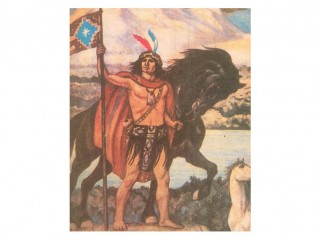
Lautaro biography
Date of birth : -
Date of death : -
Birthplace : Araucania,Chile
Nationality : Chilean
Category : Historian personalities
Last modified : 2011-10-13
Credited as : La Araucana, Araucanian Indian chieftain,
Lautaro (ca. 1535-1557) was an Araucanian Indian chieftain from southern Chile who led a rebellion against the Spanish conquistadores and settlers. He later came to symbolize the Chilean people's love of independence.
Little is known of the origins of Lautaro beyond the fact that he was born in Araucania in southern Chile and was taken prisoner by the Spaniards when he was 15. He became groom to Pedro de Valdivia, the conqueror of Chile. Lautaro (whom the Spaniards called Alonso) carefully observed the Spaniards' tactics and mode of warfare, noting their vulnerable points to such good effect that, when the warlike Araucanians rose against the Spanish in 1553, he was able to escape to the Indians and in spite of his youth win acceptance as their leader.
Lautaro quickly revealed extraordinary gifts of military inventiveness and generalship. He neutralized the Spaniards' employment of cavalry, which had hitherto given them overwhelming advantage, by constructing defenses of palisades and concealed pits and by wearing the Spanish soldiers down by wave after wave of attack until they were completely exhausted. He showed himself a master of surprise attacks, ambushes, cutting of communications, and choice of favorable terrain for bringing the enemy to battle. After seizing the fort of Tucapel near Concepcion, the chief Spanish city of the frontier region, the Araucanians under Lautaro's leadership ambushed and destroyed the force sent to retake it. On Christmas Day, 1553, Lautaro's old master, Valdivia, was himself captured and executed.
Two months later Valdivia's successor, Francisco de Villagra, was defeated by Lautaro at Marigeu. The Spaniards evacuated Concepcion and began the long withdrawal northward toward Santiago, the colony's capital. Lautaro's warriors were prevented by lack of discipline and by exhaustion caused by hunger and typhus from following up their pursuit.
In 1556 Lautaro gathered together a picked force and started a fresh drive toward Santiago. The less warlike Indians encountered on his path were given the choice of joining him or of death. The Araucanians had now captured a number of horses from the Spaniards and learned to put them to good use.
The Spaniards, with some loyal Indian auxiliaries, at last succeeded in forcing Lautaro back over the Maule River, halfway between Concepcion and Santiago. But, recrossing that river, Lautaro advanced toward the capital as far as the river Mataquito, where he encamped. There the Spaniards and their auxiliaries caught the Araucanians off their guard. Lautaro and the pick of his troops perished after a desperate resistance. The head of the young chieftain—he was about 22—was triumphantly displayed in Santiago, and the settlers were able to return to the southern frontier.
Lautaro's heroism passed into legend and was particularly celebrated in the famous epic poem La Araucana by Alonso de Ercilla. When the Chileans fought for emancipation from Spain in the early 19th century, his name was given fresh luster as the symbol of the will for national independence.
Lautaro's career was too short to lend itself to full biographical treatment. It can best be followed in works on Pedro de Valdivia and the conquest of Chile: Robert B. Cunninghame Graham, Pedro de Valdivia: Conqueror of Chile (1926); I. S. W. Vernon, Pedro de Valdivia: Conquistador of Chile (1946); and Hugh R. S. Pocock, The Conquest of Chile (1967). □
















